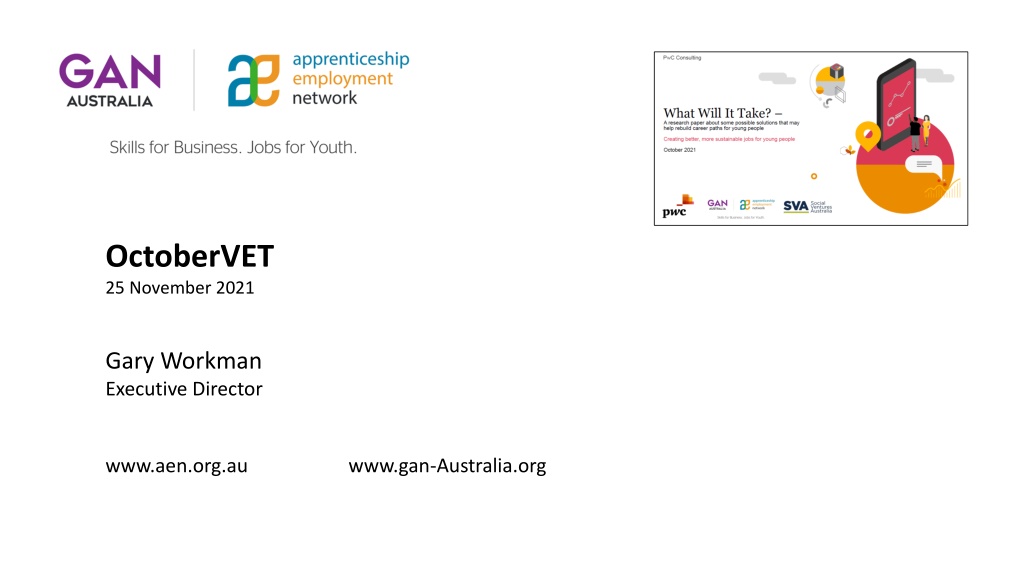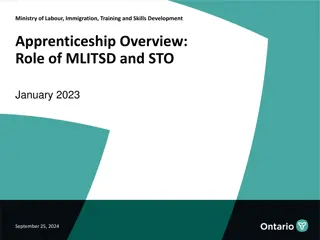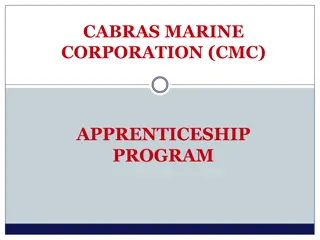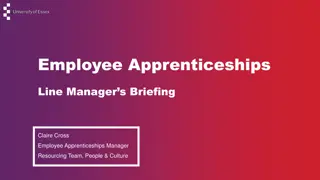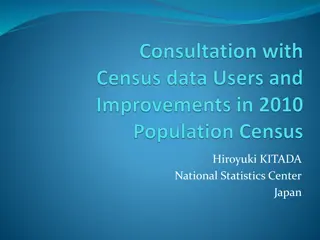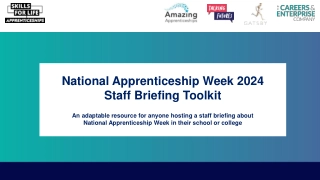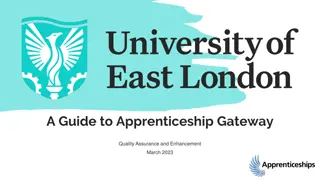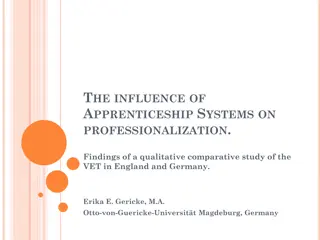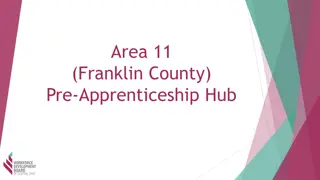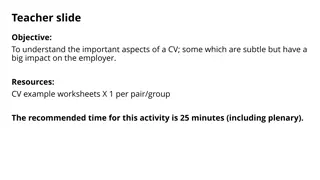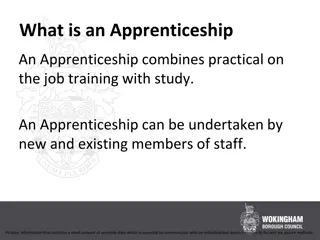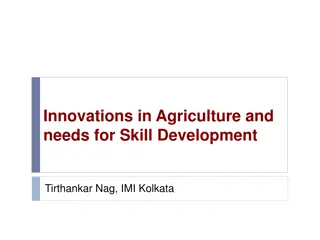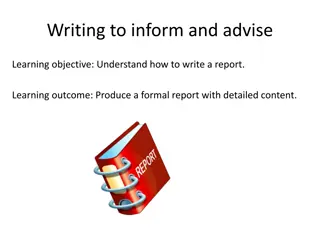Challenges and Innovations in the Apprenticeship Environment: A Report
Recent challenges in the apprenticeship sector due to workplace and community lockdowns have led to suspensions and cancellations affecting industries like Hairdressing, Chefs, and more. The support programs introduced aim to boost apprenticeship commencements and completion rates, with initiatives like wage subsidies and local employment facilitators playing key roles. Despite the obstacles posed by COVID-19, efforts are being made to ensure the continuity and success of apprenticeship programs.
- Apprenticeship challenges
- Support programs
- COVID-19 impacts
- Workforce development
- Training initiatives
Download Presentation

Please find below an Image/Link to download the presentation.
The content on the website is provided AS IS for your information and personal use only. It may not be sold, licensed, or shared on other websites without obtaining consent from the author. Download presentation by click this link. If you encounter any issues during the download, it is possible that the publisher has removed the file from their server.
E N D
Presentation Transcript
OctoberVET 25 November 2021 Gary Workman Executive Director www.aen.org.au www.gan-Australia.org
Agenda Recent Apprenticeship Environment Support Programs What will it take report
Group Training Organisations are an alternative way to start an apprenticeship GTO benefits include; Recruitment Provides flexibility / rotations Payroll and IR Arrange the training Apprentice mentoring OH&S and PPE
Our members support a wide range of people across the State and employ over 6000 apprentices each year www.aen.org.au
Current Apprenticeship environment Recent challenges Workplace / community lockdowns between April 2020 October 2021 Apprenticeship suspensions / cancellations Most effected include Hairdressing, Chefs, Automotive, Childcare, Metropolitan Melbourne, Geelong, Gippsland, Shepperton Mandatory workplace vaccinations (reduced access to vaccinations for youth) AEN providing a support service for retrenched apprentices and trainees Hands-on training has been limited during COVID, creating delays in completing qualifications Source: AEN Power BI report dashboard
Recent programs to support youth Job seeker, Jobkeeper, Job Trainer programs Boosting Apprenticeship Commencements 50% wage subsidy (Oct 2020 March 2021) Completing Apprenticeships 10% 2nd year, 5% third year wage subsidies (March 2022 30 June 2024) Local Employment Facilitators (54 regions across Australia) Victorian Government Victorian Apprenticeship Recovery Program (local government agencies & bush fire effected regions). Jobs Victoria Employment Facilitators, specific Jobs Victoria programs New Apprenticeships Victoria Victorian Major Projects (over $20m) 1500 apprentices, Social Procurement requirements, MPSG 10% of the workforce to be apprentices/ trainees/ cadets. Local Jobs First - Major Projects Skills Guarantee
In-training as at 31 March 2021 There were 329 585 apprentices and trainees in-training as at 31 March 2021, an increase of 20.7% from 31 March 2020. Quarterly training activity In the March quarter 2021, compared with the March quarter 2020: commencements increased by 35.4%, to 66 635 completions decreased by 9.4%, to 20 010 cancellations and withdrawals increased by 5%, to 22 140 Source: NCVER March Quarter 2021 Apprenticeships
The challenge Over the last decade quality job opportunities for young people in Australia have declined. Underemployment has increased, average working hours reduced. Young peoples wages have gone backwards. In 2020 the Productivity Commission found that young people are starting further down the career ladder and climbing it more slowly. It suggested that rather than focussing on unemployment, we need to start talking about the types of jobs young people are getting. Despite long term skills shortages across many parts of the labour market, there is a lack of employment pathways for young people that allow them to apply and develop their skills. We should expect this to worsen in response to COVID-19, as it has in response to past economic shocks. Uncertain economic times make employers reluctant to make long term commitments to new recruits and reduce their inclination to hire inexperienced workers. Training budgets are often the first to be cut. It is clear that Government action can make a difference. The Boosting Apprenticeship Commencements scheme (BAC) 217,000 (Nov 2021) has been effective in increasing the number of apprentices and trainees hired, including amongst employers new to the apprenticeship system. Governments have successfully used major infrastructure projects to drive investment in construction skills. Individual employers, too, have developed innovative new pathways for young people into and within their organisations, proactively engaging with low income and marginalised groups.
Themes from literature 1. 2. 3. Number of full time entry level positions has declined Employer contribution to training has been falling Employer perceptions of young people and lack of sense of responsibility to nurture new entrants, contributes Reduction in recruitment pathways in larger public sector (privatisation, corporatisation) and private sector (increased use of contractors, labour hire) employers. More fragmented labour market. Employer demand for experience/qualifications, even in entry level roles. Lack (loss?) of expertise & internal structure to bring in young people. Challenges in employers engaging with employment programs (eg, jobactive) around career pathways misalignment of objectives and expectations. Initiatives to improve pathways are often ad hoc/short term, no reliable, consistent support. 4. 5. 6. 7. 8.
Key findings from employer research There are some exceptional employer initiatives and examples of what works . But not enough to address the problem. Many employers are not set up to engage and support young workers: Identify need for workers who are productive from day 1 (half say their staff don t have time to supervise young workers) Say that young workers need more mentoring/support than usual 60% say supervisors/TL lack skills to manage & support young workers Cost is a significant factor 75% say they would take on more young people if incentives higher 61% say that cost is an important factor in limiting young peoples access to training But current incentives often seen as more trouble than they are worth Intermediary support is not hitting the mark Skills shortages are self-perpetuating, as more experienced workers are kept on the tools rather than deployed to skill up future workers.
What has been tried What employers need! Strong focus by government on Wage subsidies and a wide range of local programs Strong support to find and support youth Support to navigate the VET system
Key Findings It is clear from this research that a combination of measures is needed to generate change. We identified five broad approaches, some combination of which should be considered: We have identified a number of possible next steps to test and refine these ideas. Importantly, we need to recognise the urgency of the problem and to develop a more coherent response which recognises the need to address skills development and employment together, not in isolation.
Next Steps What we could do next: Using this paper as a starting point for co-design of a strategy to integrate current skill organisation pilots with support for employers who are willing to create additional entry points for young people, particularly those facing disadvantage. Trialling a combination of procurement targets in large IT contracts, new training/work integrated learning models and enhanced intermediary support to accelerate creation of job pathways into the IT sector; Piloting the use of an enhanced Group Training Model, with funds to deliver pre-employment and other support, to bring together employers and create better supported pathways for young people in SMEs;
Thank you for your time Gary Workman Executive Director 03 9639 3955 gary@aen.org.au To access the full report please visit www.aen.org.au www.gan-Australia.org
